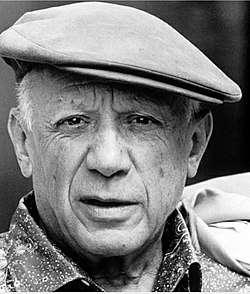Science and Charity
Science and Charity is an oil painting by Pablo Picasso painted in Barcelona in 1897 and now is part of the permanent collection of the Museu Picasso, Barcelona.[1] This is one of the most representative works of the artist's early years of training and he painted it when he was only 15 years old.
| Science and Charity | |
|---|---|
| Artist | Pablo Picasso |
| Year | 1897 |
| Medium | Oil on canvas |
| Dimensions | 197 cm × 249.5 cm (78 in × 98.2 in) |
| Location | Museu Picasso, Barcelona |
The painting shows a sick patient in bed, with on the left a doctor taking a pulse. At right, a nurse in nun's habit holds out a cup to the patient, while holding a toddler with her other arm.
History
José Ruiz y Blasco, Picasso's father, was a professor of painting who felt he had failed in his own attempts to become a renowned artist. He wanted his son to succeed in the world of professional painting and offered Picasso a strong academic background with hopes that he would be featured at the National Exhibition of Fine Arts in Madrid. Picasso began his academic training in Coruña and also studied in Barcelona at the Llotja School.
In 1896 Picasso received rave reviews for his work The First Communion, presented at the Third Exhibition of Arts and Artistic Industries in Barcelona. This encouraged his father to rent a workshop for his son at No. 4 of La Plata Street in the Ribera neighborhood, near the family home on the La Mercè Street. It was in this workshop where a Picasso painted Science and Charity. He was 15 years old.
It is believed that the work was inspired by Enrique Paternina, Mother's Visit[2] and A Hospital Room during the visit of the Head Doctor by the Sevillian painter Luis Jiménez Aranda. Picasso had previously painted a picture of a similar theme (the Sick Woman, painted in Coruña in 1894).
To prepare the work, Picasso made several previous notes and sketches. The Museu Picasso conserves 6 sketches of this work that are displayed by turns in the permanent collection. One of this sketches is painted on the back of another work, the Portrait of Joan Vidal Ventosa.[3]
Once completed, the painting was presented at the General Exhibition of Fine Arts in 1897 in Madrid, and later in the Málaga Provincial Exhibition of the same year. Once the exhibition was closed, the work would remain in Málaga, at the home of Salvador Ruiz Blasco, Picasso's uncle. When Blasco died in 1918 his widow sent the work to Barcelona, where it hung in the home of Vilató Ruiz family on Passig de Gracia until the artist donated it to the museum, along with other works. Science and Charity entered the museum with the registration number MPB110.0465[4] and is exhibited in Gallery 13.
Description
This is a work related to the social realism, a trending style during the second half of the nineteenth century. The expansion of the industrial revolution had consolidated bourgeoisie needed to flaunt their new status. Influenced by writers such as Emile Zola, some painters began to paint works for this new bourgeoisie, who liked social realism. The interest in science and medical topics made this theme recur across Europe. So hospital painting emerged, a subgenre of social realism which flourished between 1880 and 1900.
The composition of the large painting, follows a classical structure, where all the characters contribute towards aiming to focus all our attention on the sick patient. The ambience and room dimensions contribute to create an intimate and welcoming atmosphere.
Models
- Doctor: the doctor's figure is represented by José Ruiz Blasco, Picasso's father, and represents modern medicine, progress.
- Sick Jesus and child: is a neighborhood beggar and his son, whom Picasso hired as models for a total of 10 pesetas.
- Nun: It is believed that Picasso used a friend or teenager, asking her to dress up in the costumes of a nun friend of the family who came from Malaga but resided at that time in Barcelona. The nun represents asistencial relief.[5]
Exhibitions
During the fall of 2010 the Museu Picasso displayed a small temporary exhibition based on the study of this work, "Science and Charity, revealed".[6] The exhibition could see several themed works by other painters as clinical Antonio Casanova, Théobald Chartran, Heny Geoffroy Van Leo was performed Aken, Arturo Michelena and Marc Aurèle de Foy Suzor-Coté-among others. Other exhibitions:
- 1980 – Pablo Picasso: A retrospective. Museum of Modern Art, New York (May to September)
- 1982 – Picasso 1981–1973. Retrospective exhibition. Museu Picasso, Barcelona (January–February)
Prizes
- 1897 – Honorable Mention in the National Exhibition of Fine Arts in Madrid
- 1897 – Gold Medal at the Provincial Exhibition in Malaga
Bibliography
- Rafart Panas, Claustre (1998). Museu Picasso Guide. Barcelona: Barcelona City Council. p. 21. ISBN 84-7609-869-3.
- DDAA (2010). Ciencia y caridad al descubierto. Col·lecció Focus. Barcelona: Museu Picasso, Barcelona. ISBN 978-84-9850-277-0.
External links
References
- "File of the work Science and Charity on the Museu Picasso website". Museu Picasso, Barcelona. Retrieved 14 November 2014.
- Ribas Tur, Antoni (30 November 2010). "El moll de l'os de 'Ciència i caritat' (catalan)". Diari Ara. Retrieved 14 November 2014.
- These works have the registration numbers MPB 70.802, MPB 110.089, MPB 110.099, MPB 110.214, MPB 110.229, MPB 110.387 y MPB70.802R
- Rafart Planas, Claustre (1998). Guia del Museu Picasso. Barcelona: Ajuntament de Barcelona. p. 21. ISBN 84-7609-869-3.
- Gual, Malén (2010). Ciència i caritat al descobert (Col·lecció Focus). Barcelona: Museu Picasso, Barcelona. p. 16. ISBN 978-84-9850-277-0.
- "El Museu Picasso centra la programación en la investigación sobre la figura y a obra del artista malagueño". 3cat24.cat.
